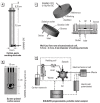Electrochemical sensors for the detection of lead and other toxic heavy metals: the next generation of personal exposure biomonitors
- PMID: 18087583
- PMCID: PMC2137133
- DOI: 10.1289/ehp.10190
Electrochemical sensors for the detection of lead and other toxic heavy metals: the next generation of personal exposure biomonitors
Abstract
To support the development and implementation of biological monitoring programs, we need quantitative technologies for measuring xenobiotic exposure. Microanalytical based sensors that work with complex biomatrices such as blood, urine, or saliva are being developed and validated and will improve our ability to make definitive associations between chemical exposures and disease. Among toxic metals, lead continues to be one of the most problematic. Despite considerable efforts to identify and eliminate Pb exposure sources, this metal remains a significant health concern, particularly for young children. Ongoing research focuses on the development of portable metal analyzers that have many advantages over current available technologies, thus potentially representing the next generation of toxic metal analyzers. In this article, we highlight the development and validation of two classes of metal analyzers for the voltammetric detection of Pb, including: a) an analyzer based on flow injection analysis and anodic stripping voltammetry at a mercury-film electrode, and b) Hg-free metal analyzers employing adsorptive stripping voltammetry and novel nanostructure materials that include the self-assembled monolayers on mesoporous supports and carbon nanotubes. These sensors have been optimized to detect Pb in urine, blood, and saliva as accurately as the state-of-the-art inductively coupled plasma-mass spectrometry with high reproducibility, and sensitivity allows. These improved and portable analytical sensor platforms will facilitate our ability to conduct biological monitoring programs to understand the relationship between chemical exposure assessment and disease outcomes.
Keywords: biomonitoring; dosimetry technology; electrochemical sensors; exposure assessment; lead (Pb).
Figures








Similar articles
-
Microanalyzer for biomonitoring lead (Pb) in blood and urine.Anal Bioanal Chem. 2007 Jan;387(1):335-41. doi: 10.1007/s00216-006-0940-1. Epub 2006 Nov 22. Anal Bioanal Chem. 2007. PMID: 17119936
-
Economic bismuth-film microsensor for anodic stripping analysis of trace heavy metals using differential pulse voltammetry.Anal Bioanal Chem. 2005 Nov;383(5):839-47. doi: 10.1007/s00216-005-0083-9. Epub 2005 Nov 5. Anal Bioanal Chem. 2005. PMID: 16215756
-
Detection of Cd, Pb, and Cu in non-pretreated natural waters and urine with thiol functionalized mesoporous silica and Nafion composite electrodes.Anal Chim Acta. 2008 Jul 14;620(1-2):55-63. doi: 10.1016/j.aca.2008.05.029. Epub 2008 May 21. Anal Chim Acta. 2008. PMID: 18558124 Free PMC article.
-
Modified electrodes used for electrochemical detection of metal ions in environmental analysis.Biosensors (Basel). 2015 Apr 29;5(2):241-75. doi: 10.3390/bios5020241. Biosensors (Basel). 2015. PMID: 25938789 Free PMC article. Review.
-
Nanotechnology-based electrochemical sensors for biomonitoring chemical exposures.J Expo Sci Environ Epidemiol. 2009 Jan;19(1):1-18. doi: 10.1038/jes.2008.71. Epub 2008 Nov 19. J Expo Sci Environ Epidemiol. 2009. PMID: 19018275 Free PMC article. Review.
Cited by
-
Heavy metals and minerals contents in pikeperch (Sander lucioperca), carp (Cyprinus carpio) and flathead grey mullet (Mugil cephalus) from Sidi Salem Reservoir (Tunisia): health risk assessment related to fish consumption.Environ Sci Pollut Res Int. 2017 Aug;24(24):19494-19507. doi: 10.1007/s11356-017-9586-0. Epub 2017 Jul 5. Environ Sci Pollut Res Int. 2017. PMID: 28677042
-
Stamping Nanoparticles onto the Electrode for Rapid Electrochemical Analysis in Microfluidics.Micromachines (Basel). 2021 Jan 6;12(1):60. doi: 10.3390/mi12010060. Micromachines (Basel). 2021. PMID: 33419157 Free PMC article.
-
Electrochemical sensing in paper-based microfluidic devices.Lab Chip. 2010 Feb 21;10(4):477-83. doi: 10.1039/b917150a. Epub 2009 Dec 3. Lab Chip. 2010. PMID: 20126688 Free PMC article.
-
Solvent-Free Preparation of Tannic Acid Carbon Dots for Selective Detection of Ni2+ in the Environment.Int J Mol Sci. 2022 Jun 15;23(12):6681. doi: 10.3390/ijms23126681. Int J Mol Sci. 2022. PMID: 35743129 Free PMC article.
-
In vitro and in vivo evaluation of a novel ferrocyanide functionalized nanopourous silica decorporation agent for cesium in rats.Health Phys. 2010 Sep;99(3):420-9. doi: 10.1097/HP.0b013e3181bca9b0. Health Phys. 2010. PMID: 20699707 Free PMC article.
References
-
- Banks EC, Ferretti LE, Shucard DW. Effects of low level of lead exposure on cognitive function in children: a review of behavioral, neuropsychological and biological evidence. Neurotoxicol. 1997;18(1):237–281. - PubMed
-
- Beck BD. An update on exposure and effects of lead. Fundam Appl Toxicol. 1992;18(1):1–16. - PubMed
-
- Bellinger DC. Lead. Pediatrics. 2004;113:1016–1022. - PubMed
-
- Birnbaum JC, Busche B, Lin Y, Shaw WJ, Fryxell GE. Synthesis of carbamoylphosphonate silanes for the selective sequestration of actinides. Chem Commun. 2002;13:1374–1375. - PubMed
Publication types
MeSH terms
Substances
Grants and funding
LinkOut - more resources
Full Text Sources

